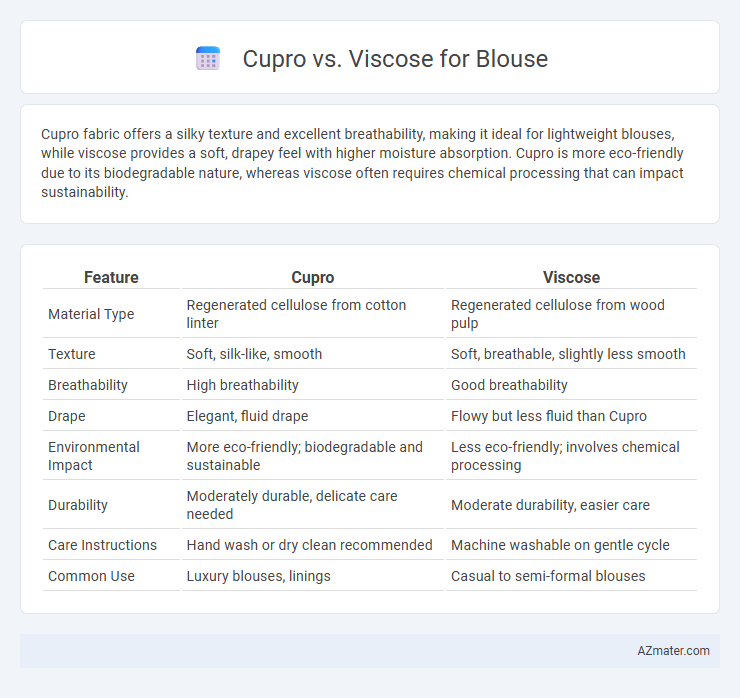Cupro fabric offers a silky texture and excellent breathability, making it ideal for lightweight blouses, while viscose provides a soft, drapey feel with higher moisture absorption. Cupro is more eco-friendly due to its biodegradable nature, whereas viscose often requires chemical processing that can impact sustainability.
Table of Comparison
| Feature | Cupro | Viscose |
|---|---|---|
| Material Type | Regenerated cellulose from cotton linter | Regenerated cellulose from wood pulp |
| Texture | Soft, silk-like, smooth | Soft, breathable, slightly less smooth |
| Breathability | High breathability | Good breathability |
| Drape | Elegant, fluid drape | Flowy but less fluid than Cupro |
| Environmental Impact | More eco-friendly; biodegradable and sustainable | Less eco-friendly; involves chemical processing |
| Durability | Moderately durable, delicate care needed | Moderate durability, easier care |
| Care Instructions | Hand wash or dry clean recommended | Machine washable on gentle cycle |
| Common Use | Luxury blouses, linings | Casual to semi-formal blouses |
Introduction: Cupro vs Viscose for Blouses
Cupro and viscose are popular fibers used in blouse fabrics, each offering unique attributes that influence comfort and style. Cupro, a regenerated cellulose fiber derived from cotton linter, delivers a silky texture and excellent breathability, making it suitable for lightweight, luxurious blouses. Viscose, sourced from wood pulp, provides a smooth, drapey feel with vibrant color retention, ideal for flowy, elegant blouse designs.
What is Cupro?
Cupro is a regenerated cellulose fiber made from cotton linter, known for its silk-like texture and breathability, making it ideal for lightweight blouses. Unlike viscose, which is produced from wood pulp and often requires more chemical processing, cupro offers a smoother finish, enhanced moisture absorption, and excellent drape. Its eco-friendly recycling process and biodegradable nature position cupro as a sustainable alternative for soft, luxurious fabric in blouse design.
What is Viscose?
Viscose is a semi-synthetic fiber made from regenerated cellulose derived from wood pulp, known for its silk-like feel and breathability, making it a popular choice for blouses. It offers excellent moisture absorption, drapes beautifully, and provides a smooth, soft texture, enhancing comfort in warm weather. Compared to Cupro, viscose tends to be more affordable but can wrinkle easily and may require gentle care to maintain its shape and durability.
Key Differences Between Cupro and Viscose
Cupro is a regenerated cellulose fabric derived from cotton linter, known for its silk-like sheen, smooth texture, and breathability, making it ideal for high-end blouses. Viscose, also made from cellulose, is more versatile and cost-effective but tends to be less durable and prone to shrinking compared to Cupro. Key differences include Cupro's superior moisture-wicking properties and eco-friendly production process, whereas Viscose offers greater variety in weight and drape but with a higher environmental impact.
Fabric Feel and Comfort
Cupro fabric offers a silky, smooth texture with excellent breathability, making it ideal for blouses that require a soft, luxurious feel against the skin. Viscose also provides a soft touch but tends to be more absorbent and slightly heavier, which may affect comfort in warmer climates. Both fabrics drape well, but Cupro's natural fibers enhance moisture-wicking properties, resulting in superior comfort during extended wear.
Breathability and Moisture-Wicking
Cupro fabric offers superior breathability compared to viscose, making it ideal for hot, humid climates by allowing air to circulate effectively and keeping the skin cool. Its natural moisture-wicking properties draw sweat away from the body, enhancing comfort during prolonged wear. Viscose, while soft and lightweight, tends to retain moisture, which can lead to a clammy feel, making cupro a better choice for breathable and moisture-managing blouses.
Sustainability and Eco-Friendliness
Cupro, derived from cotton waste fibers, is highly sustainable due to its biodegradable properties and closed-loop production process that recycles chemicals and water, minimizing environmental impact. Viscose, though made from natural cellulose, often involves energy-intensive manufacturing and toxic chemicals, raising concerns about deforestation and pollution unless sourced from certified sustainable plantations. Choosing cupro blouses supports eco-conscious fashion by reducing waste and chemical emissions compared to conventional viscose production.
Durability and Care Requirements
Cupro fabric exhibits superior durability compared to viscose, offering enhanced resistance to wear and tear, making it ideal for frequently worn blouses. Cupro is made from regenerated cellulose fibers derived from cotton linter, providing a smoother texture that withstands multiple washes without significant degradation. Viscose, while soft and breathable, tends to weaken when wet and requires delicate hand washing or dry cleaning to maintain fabric integrity over time.
Price Comparison: Cupro vs Viscose
Cupro fabric generally costs more than viscose due to its complex production process and higher quality feel. Viscose is more affordable and widely available, making it a popular choice for budget-conscious consumers. The price difference between cupro and viscose blouses reflects the durability and silk-like texture typical of cupro compared to the softness and versatility of viscose.
Which Fabric is Best for Blouses?
Cupro offers a luxurious feel with excellent breathability and moisture-wicking properties, making it ideal for high-end blouses that require comfort and elegance. Viscose provides a soft texture and vibrant drape but tends to be less durable and more prone to shrinkage and wrinkles compared to cupro. For blouses demanding a balance of durability, smooth finish, and sustainability, cupro is generally the better fabric choice.

Infographic: Cupro vs Viscose for Blouse
 azmater.com
azmater.com